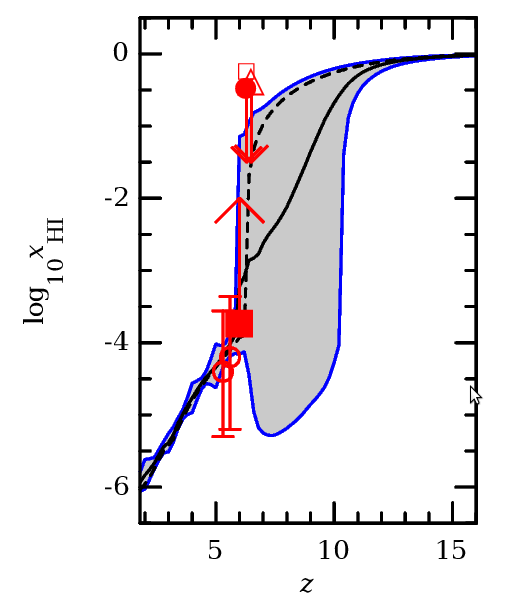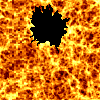I have interests in various aspects of cosmology. At present, I devote most of my time studying a cosmological process called "reionization". I have described some background related to reionization below. If you want to know more, you will have to take a look at my research publications. Some details are also available as part of my resume.
Cosmological Reionization:
In the framework of the hot big bang model, our Universe is expected to become almost neutral around 400,000 years after the big bang. On the other hand, we know from observations of quasar absorption spectra that the same Universe has become highly ionized by the time it is one Gigayear old. This implies that the Universe must have been "reionized" sometime in between.
As per our current understanding, the reionization of the Universe is driven by radiation from first luminous sources (galaxies/stars). Studying reionization will thus tell us how the first stars formed and how different they were from stars we see around us. In addition, reionization is extremely important for studying cosmology in general as the details of it affects determination of cosmological parameters from observations.
Modelling Reionization:
We have been involved in modelling the process of reionization and comparing these models with different observations. We find that the model we developed can match a wide variety of observational data sets. In fact, we can give limits on various quantities related to reionization using the model. For example, the figure below shows the limits on the fraction of neutral gas (primarily hydrogen) as a function of redshift (which acts as a proxy for time in cosmology). The constraints are obtained using observations related to the cosmic microwave background radiation (CMBR) and absorption systems observed in quasar spectra.

21 cm Experiments:
As one can see, there is a range in redshifts where reionization is not very well constrained. There are various ongoing and planned observational projects to constrain the reionization history at these redshifts. One promising method is to detect the fluctuations in the neutral hydrogen density during the reionization era through its hyperfine transition using facilities like LOFAR, MWA, GMRT, CMA, SKA.
We developed numerical simulations to generate realistic maps of 21 cm emission arising from the hyperfine transition. The neutral hydrogen distribution before reionization is expected to be complex and patchy and is best modelled with numerical simulations. Since very little is known about the detailed physical processes at such early epochs, we have to make different assumptions and then verify the assumptions by comparing with the data. Hence, we generate maps for various scenarios and try to get an idea how to distinguish between them from the data.

The picture shows a sample of a two-dimensional 21 cm map from our numerical simulations when the Universe is 75 per cent ionized. The ionized matter is represented by dark colour. The distribution of the ionized regions is quite patchy, with small neutral blobs residing within the ionized regions.
The Intergalactic Medium:
We believe that reionization was completed at redshitfs around 6, following which the Universe is in a post-reionization phase. Many cosmologically interesting information at these epochs are contained within the highly ionized "intergalactic medium". This medium is nothing but a distribution of diffuse gas between the galaxies. It is very well probed by the absorption lines in quasar spectra. Some sample spectra from our models are shown below:

The fluctuations seen in the spectra trace the matter density fluctuations between the distant quasar and us. We can thus use them to study the Universe at very large distances, i.e., at very early times. We have studied these spectra to put constraints on the amount of neutral matter, and also study the state of the gas (e.g., temperature, amount of radiation present etc).